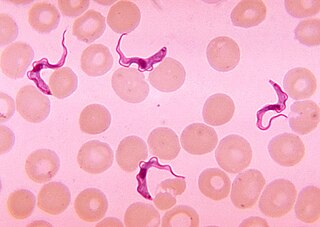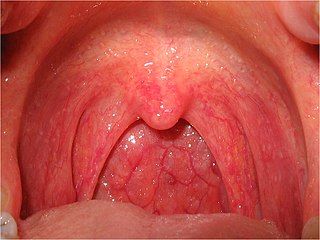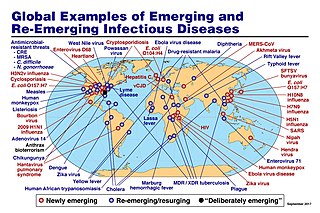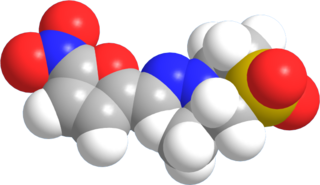Related Research Articles

Typhoid fever, also known simply as typhoid, is a disease caused by Salmonella enterica serotype Typhi bacteria, also called SalmonellaTyphi. Symptoms vary from mild to severe, and usually begin six to 30 days after exposure. Often there is a gradual onset of a high fever over several days. This is commonly accompanied by weakness, abdominal pain, constipation, headaches, and mild vomiting. Some people develop a skin rash with rose colored spots. In severe cases, people may experience confusion. Without treatment, symptoms may last weeks or months. Diarrhea may be severe, but is uncommon. Other people may carry it without being affected, but are still contagious. Typhoid fever is a type of enteric fever, along with paratyphoid fever. Salmonella enterica Typhi is believed to infect and replicate only within humans.

A zoonosis or zoonotic disease is an infectious disease of humans caused by a pathogen that can jump from a non-human to a human and vice versa.
Dengue fever is a mosquito-borne tropical disease caused by dengue virus. It is frequently asymptomatic; if symptoms appear they typically begin 3 to 14 days after infection. These may include a high fever, headache, vomiting, muscle and joint pains, and a characteristic skin itching and skin rash. Recovery generally takes two to seven days. In a small proportion of cases, the disease develops into severedengue with bleeding, low levels of blood platelets, blood plasma leakage, and dangerously low blood pressure.

Fever or pyrexia in humans is a body temperature above the normal range due to an increase in the body's temperature set point in the hypothalamus. There is no single agreed-upon upper limit for normal temperature: sources use values ranging between 37.2 and 38.3 °C in humans. The increase in set point triggers increased muscle contractions and causes a feeling of cold or chills. This results in greater heat production and efforts to conserve heat. When the set point temperature returns to normal, a person feels hot, becomes flushed, and may begin to sweat. Rarely a fever may trigger a febrile seizure, with this being more common in young children. Fevers do not typically go higher than 41 to 42 °C.

Perspiration, also known as sweat, is the fluid secreted by sweat glands in the skin of mammals.

Streptococcal pharyngitis, also known as streptococcal sore throat, is pharyngitis caused by Streptococcus pyogenes, a gram-positive, group A streptococcus. Common symptoms include fever, sore throat, red tonsils, and enlarged lymph nodes in the front of the neck. A headache and nausea or vomiting may also occur. Some develop a sandpaper-like rash which is known as scarlet fever. Symptoms typically begin one to three days after exposure and last seven to ten days.

African trypanosomiasis, also known as African sleeping sickness or simply sleeping sickness, is an insect-borne parasitic infection of humans and other animals. It is caused by the species Trypanosoma brucei. Humans are infected by two types, Trypanosoma brucei gambiense (TbG) and Trypanosoma brucei rhodesiense (TbR). TbG causes over 92% of reported cases. Both are usually transmitted by the bite of an infected tsetse fly and are most common in rural areas.

Pharyngitis is inflammation of the back of the throat, known as the pharynx. It typically results in a sore throat and fever. Other symptoms may include a runny nose, cough, headache, difficulty swallowing, swollen lymph nodes, and a hoarse voice. Symptoms usually last 3–5 days, but can be longer depending on cause. Complications can include sinusitis and acute otitis media. Pharyngitis is a type of upper respiratory tract infection.

Chikungunya is an infection caused by the Chikungunya virus (CHIKV). The disease was first identified in 1952 in Tanzania and named based on the Kimakonde words for "to become contorted". Symptoms include fever and joint pain. These typically occur two to twelve days after exposure. Other symptoms may include headache, muscle pain, joint swelling, and a rash. Symptoms usually improve within a week; however, occasionally the joint pain may last for months or years. The risk of death is around 1 in 1,000. The very young, old, and those with other health problems are at risk of more severe disease.
Sweating sickness, also known as the sweats, English sweating sickness, English sweat or sudor anglicus in Latin, was a mysterious and contagious disease that struck England and later continental Europe in a series of epidemics beginning in 1485. Other major outbreaks of the English sweating sickness occurred in 1508, 1517, and 1528, with the last outbreak in 1551, after which the disease apparently vanished. The onset of symptoms was sudden, with death often occurring within hours. Sweating sickness epidemics were unique compared with other disease outbreaks of the time: whereas other epidemics were typically urban and long-lasting, cases of sweating sickness spiked and receded very quickly, and heavily affected rural populations. Its cause remains unknown, although it has been suggested that an unknown species of hantavirus was responsible.

Miliary tuberculosis is a form of tuberculosis that is characterized by a wide dissemination into the human body and by the tiny size of the lesions (1–5 mm). Its name comes from a distinctive pattern seen on a chest radiograph of many tiny spots distributed throughout the lung fields with the appearance similar to millet seeds—thus the term "miliary" tuberculosis. Miliary TB may infect any number of organs, including the lungs, liver, and spleen. Miliary tuberculosis is present in about 2% of all reported cases of tuberculosis and accounts for up to 20% of all extra-pulmonary tuberculosis cases.

Carrion's disease is an infectious disease produced by Bartonella bacilliformis infection.

An emerging infectious disease (EID) is an infectious disease whose incidence has increased recently, and could increase in the near future. The minority that are capable of developing efficient transmission between humans can become major public and global concerns as potential causes of epidemics or pandemics. Their many impacts can be economic and societal, as well as clinical. EIDs have been increasing steadily since at least 1940.
An emergent virus is a virus that is either newly appeared, notably increasing in incidence/geographic range or has the potential to increase in the near future. Emergent viruses are a leading cause of emerging infectious diseases and raise public health challenges globally, given their potential to cause outbreaks of disease which can lead to epidemics and pandemics. As well as causing disease, emergent viruses can also have severe economic implications. Recent examples include the SARS-related coronaviruses, which have caused the 2002-2004 outbreak of SARS (SARS-CoV-1) and the 2019–21 pandemic of COVID-19 (SARS-CoV-2). Other examples include the human immunodeficiency virus which causes HIV/AIDS; the viruses responsible for Ebola; the H5N1 influenza virus responsible for avian flu; and H1N1/09, which caused the 2009 swine flu pandemic. Viral emergence in humans is often a consequence of zoonosis, which involves a cross-species jump of a viral disease into humans from other animals. As zoonotic viruses exist in animal reservoirs, they are much more difficult to eradicate and can therefore establish persistent infections in human populations.

Babesia, also called Nuttallia, is an apicomplexan parasite that infects red blood cells and is transmitted by ticks. Originally discovered by the Romanian bacteriologist Victor Babeș in 1888, over 100 species of Babesia have since been identified.

Nifurtimox, sold under the brand name Lampit, is a medication used to treat Chagas disease and sleeping sickness. For sleeping sickness it is used together with eflornithine in nifurtimox-eflornithine combination treatment. In Chagas disease it is a second-line option to benznidazole. It is given by mouth.
The Picardy sweat was an infectious disease of unknown cause and one of the only diseases that bears resemblance to the English sweating sickness. The Picardy sweat is also known as the miliary fever, suette des Picards in French, and picard'scher Schweiß,picard'sches Schweissfieber, or Frieselfieber in German. It appeared in the northern French province of Picardy in 1718. The Picardy sweat was mainly confined to the northwest part of France, particularly in the provinces of Seine-et-Oise, Bas Rhin, and Oise. Although the Picardy sweat began in Northern France, outbreaks also occurred in Germany, Belgium, Switzerland, Austria, and Italy. Between 1718 and 1874, 194 epidemics of the Picardy sweat were recorded. The last extensive outbreak was in 1906, which a French commission attributed to fleas from field mice. A subsequent case was diagnosed in 1918 in a soldier in Picardy.
Trench nephritis, also known as war nephritis, is a kidney infection, first recognised by medical officers as a new disease during the early part of the First World War and distinguished from the then-understood acute nephritis by also having bronchitis and frequent relapses. Trench nephritis was the major kidney problem of the war. The cause was not established at the time, treatments were ineffective, and the condition led to 35,000 British and 2,000 American casualties.
Guy Edward Thwaites is a British professor of infectious diseases at the University of Oxford, and director of the Oxford University Clinical Research Unit (OUCRU) in Ho Chi Minh City in Vietnam. His focus is on severe bacterial infections, including meningitis and Staphylococcus aureus bloodstream infection, and tuberculosis. He is a former first-class cricketer.
References
- 1 2 Wheater, M (September 1990). "Mozart's last illness--a medical diagnosis". J R Soc Med. 83 (9): 586–9. doi:10.1177/014107689008300917. PMC 1292822 . PMID 2213810.
- ↑ Murray, RD (March 1886). "Presidency General Hospital: Cases of Miliary Fever". Ind Med Gaz. 21 (3): 77–78. PMC 5001008 . PMID 28999591.
- ↑ "Miliary Fever, or the Sweating Sickness". The Lancet. 168 (4342): 1374–1375. 17 November 1906. doi:10.1016/S0140-6736(00)68887-6 . Retrieved 11 February 2024.
- ↑ Renbourn, ET (May 1958). "The history of sweat and prickly heat, 19th-20th century". J Invest Dermatol. 30 (5): 249–59. doi:10.1038/jid.1958.50. PMID 13549798 . Retrieved 11 February 2024.
- ↑ Cliff, AD; Smallman-Raynor, MR; et al. (2009). "'Disease Emergence and Re-emergence Prior to 1850'". Infectious Diseases: A Geographical Analysis: Emergence and Re-emergence. Oxford: Oxford Academic. p. 87. ISBN 9780199244737 . Retrieved 11 February 2024.